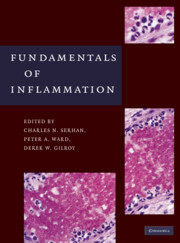Book contents
- Frontmatter
- Contents
- Contributors
- Preface
- PART I THE INFLAMMATORY RESPONSE – AN OVERVIEW
- PART II INDIVIDUAL CELL TYPES
- PART III CHEMICAL MEDIATORS
- PART IV IMMUNOPHARMACOLOGY
- PART V INFLAMMATORY DISEASES/HISTOLOGY
- PART VI ANIMAL MODELS OF INFLAMMATION
- 27 Models of Acute Inflammation – Air-Pouch, Peritonitis, and Ischemia-Reperfusion
- 28A Experimental Models of Glomerulonephritis
- 28B Glomerulonephritis and Ischemia Reperfusion Injury
- 29 Asthma
- 30 Animal Models of Rheumatoid Arthritis
- 31 Ocular Inflammation Models
- 32 Atherosclerosis in Experimental Animal Models
- 33 Oral Inflammation and Periodontitis
- 34 Pathogens and Inflammation
- Index
- References
34 - Pathogens and Inflammation
from PART VI - ANIMAL MODELS OF INFLAMMATION
Published online by Cambridge University Press: 05 April 2014
- Frontmatter
- Contents
- Contributors
- Preface
- PART I THE INFLAMMATORY RESPONSE – AN OVERVIEW
- PART II INDIVIDUAL CELL TYPES
- PART III CHEMICAL MEDIATORS
- PART IV IMMUNOPHARMACOLOGY
- PART V INFLAMMATORY DISEASES/HISTOLOGY
- PART VI ANIMAL MODELS OF INFLAMMATION
- 27 Models of Acute Inflammation – Air-Pouch, Peritonitis, and Ischemia-Reperfusion
- 28A Experimental Models of Glomerulonephritis
- 28B Glomerulonephritis and Ischemia Reperfusion Injury
- 29 Asthma
- 30 Animal Models of Rheumatoid Arthritis
- 31 Ocular Inflammation Models
- 32 Atherosclerosis in Experimental Animal Models
- 33 Oral Inflammation and Periodontitis
- 34 Pathogens and Inflammation
- Index
- References
Summary
Here, we discuss the modulation of inflammation upon pathogen invasion, including the new pathway triggered by lipoxin involved in the repression of immune response during infection, as well as this mechanism from the perspective of the pathogen, which pirates the host's lipoxygenase machinery to its own advantage as a probable immune-escape mechanism.
INNATE IMMUNITY AND PATHOGENS
It is well known that a series of pattern-recognition receptors is involved in the recognition of different microbial pathogens and induction of the innate response. Such receptors recognize distinct biochemical patterns of molecules displayed by the invading pathogen. The repertoire of innate immune receptors is very broad and includes several classes of germ-line–encoded proteins such as Toll-like receptors (TLRs), scavenger receptors, and C-type lectins. This wide array of recognition molecules allows the host to detect a variety of microbial molecules including carbohydrates, lipids, nucleic acids, and proteins [1, 2]. Distinct TLR ligands provide distinct activation status and cytokine production patterns for antigen-presenting cells (APCs), resulting in the induction of differential immune responses. Thus, TLRs are critical molecules to induce not only inflammatory responses but also fine-tune adaptive immune responses depending on invading pathogens [3]. TLRs activation can upregulate costimulatory molecules on APC, thus enhancing the activation of adaptive T-cell responses.
- Type
- Chapter
- Information
- Fundamentals of Inflammation , pp. 448 - 456Publisher: Cambridge University PressPrint publication year: 2010

